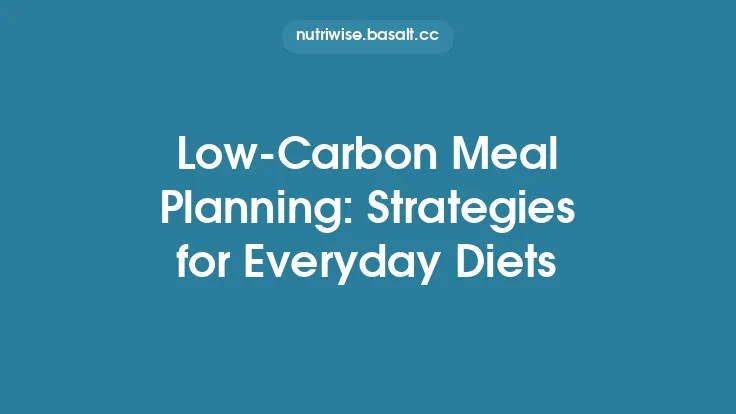Trace elements—often called trace minerals—are required in minute amounts, yet they wield outsized influence over everything from enzyme catalysis to hormone synthesis. While each element has its own distinct role, the true power of these micronutrients emerges when they work together, enhancing each other’s absorption, activation, or functional impact. For most people, the challenge isn’t finding these nutrients but ensuring that everyday food choices and habits allow the body to tap into their synergistic potential. Below are practical, evidence‑backed strategies you can weave into grocery shopping, meal preparation, and daily routines to make the most of trace element synergy without relying on isolated supplements or obscure specialty foods.
Understanding the Foundations of Trace Element Synergy
- Co‑factor Relationships – Many enzymes require a primary trace element (e.g., zinc) and a secondary organic co‑factor (e.g., vitamin B6) to achieve optimal activity. When both are present, the catalytic efficiency can increase dramatically.
- Shared Transport Pathways – Certain minerals use the same intestinal transport proteins. For example, the divalent metal transporter‑1 (DMT‑1) shuttles iron, manganese, and cobalt. Adequate levels of one can up‑regulate the transporter, indirectly boosting the uptake of the others.
- pH‑Dependent Solubility – The acidic environment of the stomach is crucial for converting many trace elements into soluble forms. Foods that stimulate gastric acid secretion (e.g., protein‑rich meals) can therefore improve the bioavailability of several minerals simultaneously.
- Competitive Inhibition vs. Mutual Enhancement – High concentrations of one mineral can block the absorption of another (e.g., excess calcium can hinder iron uptake). Conversely, certain compounds—organic acids, phytates in low amounts, and specific amino acids—can create a more favorable milieu for multiple trace elements to be absorbed together.
Understanding these underlying mechanisms helps you target the right food combinations and preparation methods rather than relying on guesswork.
Assessing Your Baseline Nutrient Profile
Before you can fine‑tune your diet, it’s useful to know where you stand.
- Dietary Recall – Keep a 3‑day food log (including one weekend day). Use a nutrition analysis tool to flag foods rich in trace elements such as magnesium, selenium, chromium, manganese, and molybdenum.
- Laboratory Screening – A basic serum panel can reveal deficiencies in iron, zinc, copper, and selenium. For a more nuanced picture, consider a comprehensive micronutrient test that includes magnesium, chromium, and manganese levels.
- Lifestyle Factors – High‑intensity training, chronic stress, and certain medications (e.g., proton‑pump inhibitors) can increase the body’s demand for specific trace elements.
Armed with this information, you can prioritize which synergies to emphasize in your meal planning.
Food Pairing Principles for Maximizing Synergy
- Acidic Pairings – Vitamin C‑rich foods (citrus, berries, bell peppers) dramatically improve non‑heme iron absorption and also aid the uptake of copper and manganese. Pair a leafy green salad with a squeeze of lemon or a handful of strawberries for a dual boost.
- Protein‑Bound Minerals – Selenium is best absorbed when bound to protein. Include selenium‑rich foods such as Brazil nuts, fish, or turkey alongside a modest protein source (e.g., a chickpea side dish) to enhance its utilization.
- Magnesium‑Potassium Tandem – Both minerals support muscle relaxation and electrolyte balance. A snack of a banana (potassium) with a small handful of almonds (magnesium) creates a natural synergy that can aid post‑exercise recovery.
- Organic Acid Boosters – Citric, malic, and tartaric acids, found in fruits like oranges, apples, and grapes, chelate trace minerals and keep them soluble. Adding a splash of apple cider vinegar to a grain bowl can improve the bioavailability of iron, manganese, and chromium simultaneously.
- Whole‑Food Matrices – Whole grains, legumes, nuts, and seeds provide a complex matrix of trace elements, fiber, and phytochemicals that often work together to modulate absorption rates. For instance, a quinoa‑based pilaf supplies magnesium, manganese, and trace amounts of molybdenum in a balanced form.
Avoid pairing high‑phytate foods (e.g., raw soy, unsoaked beans) with iron‑rich meals unless you’ve pre‑treated them (soaking, sprouting, or fermenting) to reduce the inhibitory effect.
Cooking Techniques that Preserve and Enhance Trace Elements
- Gentle Steaming – Retains water‑soluble vitamins and minimizes mineral leaching compared with boiling. Steamed broccoli, for example, preserves its manganese and chromium content.
- Short‑Duration Sautéing – A quick stir‑fry in a modest amount of oil helps release fat‑soluble cofactors (e.g., vitamin E) that protect trace elements from oxidative degradation.
- Soaking and Sprouting – Soaking beans, lentils, and seeds for 8–12 hours reduces phytate levels, thereby improving the absorption of iron, zinc, and manganese. Sprouting further activates enzymes that liberate bound minerals.
- Fermentation – Fermented foods such as kimchi, sauerkraut, and tempeh contain organic acids and probiotic bacteria that enhance mineral solubility and gut health, creating a more receptive environment for trace element uptake.
- Avoid Over‑Cooking – Prolonged high heat can degrade heat‑sensitive trace elements (e.g., selenium) and diminish the activity of accompanying enzymes. Aim for “just‑tender” textures.
Timing and Sequence: When to Consume Complementary Minerals
- Separate High‑Calcium Meals from Iron‑Rich Foods – Calcium competes for the same transport pathways as iron. If you enjoy a calcium‑dense dairy snack, schedule it at least two hours apart from a main course featuring beans, leafy greens, or red meat.
- Pair Iron with Vitamin C in the Same Meal – The synergistic effect is immediate; the acidic environment created by vitamin C converts ferric (Fe³⁺) to the more absorbable ferrous (Fe²⁺) form.
- Distribute Magnesium Throughout the Day – Since magnesium is involved in over 300 enzymatic reactions, spreading intake across meals (e.g., nuts at breakfast, leafy greens at lunch, seeds at dinner) helps maintain steady plasma levels.
- Pre‑Workout Mineral Boost – Consuming a small portion of potassium‑rich fruit (e.g., orange) with a magnesium source (e.g., pumpkin seeds) 30–45 minutes before exercise can improve muscle contractility and reduce cramping.
- Nighttime Selenium – Some research suggests that selenium’s antioxidant role aligns well with the body’s nocturnal repair processes. A modest serving of selenium‑rich fish or a Brazil nut before bed can support this cycle.
Leveraging Whole Foods and Food Groups
| Food Group | Key Trace Elements | Synergistic Companion Foods |
|---|---|---|
| Leafy Greens (spinach, kale) | Iron, manganese, magnesium | Citrus vinaigrette (vitamin C) |
| Nuts & Seeds (almonds, sunflower seeds) | Magnesium, selenium, chromium | Yogurt dip (protein) |
| Seafood (salmon, sardines) | Selenium, iodine (trace), zinc | Whole‑grain side (provides B‑vitamins) |
| Legumes (lentils, chickpeas) | Iron, manganese, molybdenum | Tomato‑based sauce (organic acids) |
| Whole Grains (quinoa, oats) | Chromium, manganese, magnesium | Fermented kefir (probiotics) |
By focusing on these groups, you naturally create meals where multiple trace elements are present in complementary forms, reducing the need for isolated supplementation.
Incorporating Fermented and Sprouted Foods
- Fermented Vegetables – The lactic acid produced during fermentation lowers gut pH, enhancing mineral solubility. A side of kimchi can increase the bioavailability of calcium, magnesium, and trace minerals from the main dish.
- Sprouted Grains – Sprouting wheat berries or buckwheat activates phytase, an enzyme that degrades phytates, thereby freeing bound iron, zinc, and manganese. A sprouted grain porridge in the morning offers a gentle, mineral‑rich start.
- Miso and Tempeh – These soy‑based ferments provide a modest amount of trace elements while also delivering beneficial microbes that improve overall gut absorption efficiency.
Practical Meal Planning Templates
1. Balanced Breakfast (≈400 kcal)
- Base: Overnight oats made with fortified oat milk (magnesium, calcium).
- Add‑in: Chia seeds (manganese, zinc) and a handful of fresh berries (vitamin C).
- Side: A single Brazil nut (selenium) for a quick antioxidant boost.
2. Mid‑Day Power Lunch (≈600 kcal)
- Salad: Mixed greens (iron, magnesium) topped with grilled salmon (selenium, iodine).
- Dressing: Lemon‑olive oil vinaigrette (vitamin C + healthy fats).
- Grain: Quinoa pilaf (chromium, manganese) with a splash of apple cider vinegar.
3. Pre‑Workout Snack (≈150 kcal)
- Combo: A banana (potassium) with a tablespoon of almond butter (magnesium).
4. Evening Dinner (≈700 kcal)
- Main: Stir‑fried tofu (protein‑bound trace minerals) with bell peppers, broccoli, and snap peas (vitamin C, manganese).
- Sauce: Tamari + ginger + a dash of fermented black bean paste (organic acids).
- Side: Brown rice (chromium) cooked with a pinch of sea salt (sodium, trace iodine).
5. Nightcap (optional, ≤100 kcal)
- Option: A cup of warm kefir (probiotics) with a drizzle of honey and a sprinkle of ground flaxseed (magnesium).
These templates can be mixed, matched, and scaled to meet individual caloric needs while preserving the core synergy principles.
Smart Supplementation Strategies
While whole foods should be the foundation, targeted supplementation can fill gaps when dietary intake is insufficient.
- Multimineral Complexes – Choose products that provide trace elements in chelated forms (e.g., magnesium glycinate, zinc picolinate). Chelation mimics natural binding partners, improving absorption.
- Timing – Take iron supplements on an empty stomach with a vitamin C source, but separate from calcium or high‑fiber meals.
- Avoid Overlap – If you already consume a diet rich in a particular trace element, additional supplementation may lead to antagonism (e.g., excess zinc impairing copper status).
- Quality Assurance – Look for third‑party testing (USP, NSF) to ensure label accuracy and minimal heavy‑metal contamination.
Monitoring and Adjusting Your Approach
- Quarterly Food Log Review – Reassess nutrient intake after any major lifestyle change (new workout regimen, pregnancy, travel).
- Follow‑Up Labs – Repeat serum or comprehensive micronutrient panels every 6–12 months to track trends.
- Symptom Check‑In – Fatigue, hair loss, or frequent infections can signal imbalances. Adjust food pairings or supplement doses accordingly.
- Gut Health Assessment – Since the microbiome influences mineral absorption, consider a stool analysis if you notice persistent digestive issues.
Common Pitfalls and How to Avoid Them
- Relying on Single‑Source Foods – Eating only one “superfood” for a particular mineral can create imbalances. Diversify across food groups.
- Neglecting Antagonists – High intake of phytate‑rich foods (unsoaked grains) alongside iron‑rich meals can blunt absorption. Use soaking, sprouting, or fermentation to mitigate.
- Over‑Supplementing – More isn’t always better. Excess trace elements can be toxic (e.g., selenium) or interfere with the uptake of others.
- Ignoring Cooking Losses – Boiling leafy greens for long periods can leach out manganese and chromium. Opt for quick sauté or steam.
- Skipping Vitamin C – Forgetting to pair vitamin C with plant‑based iron sources is a missed opportunity for synergy.
Future Directions and Emerging Research
The field of micronutrient synergy is evolving rapidly. Recent studies are exploring:
- Nanocarrier Delivery – Encapsulating trace elements in lipid‑based nanoparticles to protect them through the digestive tract and release them at specific intestinal sites.
- Genetic Polymorphisms – Variants in transport proteins (e.g., SLC30A8 for zinc) may dictate individual responsiveness to dietary strategies, paving the way for personalized nutrition plans.
- Microbiome‑Mediated Mineral Metabolism – Certain gut bacteria can convert inorganic forms of trace elements into more bioavailable organic complexes, suggesting probiotic co‑administration could become a standard practice.
Staying attuned to these developments will allow you to refine your dietary approach as new evidence emerges.
By integrating these practical strategies—thoughtful food pairings, mindful cooking methods, strategic timing, and judicious supplementation—you can unlock the full collaborative power of trace elements in everyday meals. The result is not just a diet that meets minimum requirements, but one that actively leverages micronutrient synergy to support optimal health, energy, and resilience.





